As an Amazon Associate KitchenwareSets.com earns from qualifying purchases.
Natural Earthy Kitchen Design Ideas For Warm Inviting Spaces
Do you ever walk into your kitchen and feel… nothing? It’s functional, sure. The appliances work, the counters are clean, but it lacks a soul. It feels less like the heart of your home and more like a sterile, uninspired workspace that you can’t wait to leave. It’s a common feeling in a world of cookie-cutter designs and cold, minimalist trends.
You crave a space that feels different. A kitchen that doesn’t just serve meals, but serves your well-being. You’re looking for warmth, comfort, and a sense of calm—a room that feels like a deep, relaxing breath every time you step into it. You want a kitchen that’s not just for cooking, but for living, connecting, and feeling truly at home. You’re searching for a design that grounds you.
A natural earthy kitchen design is the perfect solution, creating a warm, inviting, and tranquil atmosphere by masterfully blending organic elements, natural materials like wood and stone, and a soothing color palette inspired by nature. This design philosophy isn’t just about aesthetics; it’s about forging a seamless connection between your indoor space and the great outdoors, turning the heart of your home into a serene sanctuary.
Craving a Kitchen That Feels Like a Warm Hug? Here’s How to Get It
Does your current kitchen feel cold, sterile, or disconnected from the rest of your home’s cozy vibe? You’re not alone. Many modern kitchens prioritize function over feeling, leaving homeowners with a space that’s efficient but lacks personality and warmth. You desire a place that feels grounded, peaceful, and genuinely welcoming—a true hub for family and friends. We’ve spent years helping homeowners transform their spaces, and we know that creating a truly inviting kitchen starts with a deep connection to natural elements. This guide will walk you through the core principles and actionable ideas to create the natural earthy kitchen you’ve been dreaming of, a space that feels like a warm, comforting embrace every single day.
What Defines a Natural Earthy Kitchen in 2025?
A natural earthy kitchen in 2025 is defined by its core principles of using natural materials, warm colors, and organic textures to create a space that feels connected to the outdoors. It’s a design style rooted in biophilia—the idea that humans have an innate tendency to seek connections with nature—and it prioritizes authenticity and sustainability. Citing foundational design principles, this aesthetic is less about fleeting trends and more about creating a timeless, serene environment.
The core principles of an earthy kitchen design are:
* Prioritizing Natural Materials: This is the heart of the style. Think reclaimed wood, natural stone like granite or soapstone, clay, and organic fibers such as linen, cotton, and jute. These materials bring the imperfect beauty of the outdoors inside.
* Using a Warm Color Palette: The color scheme is pulled directly from nature. This includes a base of warm neutrals like browns, beiges, and warm whites, layered with deeper hues like olive green, terracotta, and muted slate blues.
* Maximizing Natural Light: Large, unadorned windows, glass doors, and even skylights are used to flood the space with daylight, highlighting the textures of the natural materials and strengthening the indoor-outdoor connection.
* Incorporating Rich Textures: An earthy kitchen is a feast for the senses. It layers various textures—the rough grain of wood, the smooth coolness of stone, the softness of linen, and the coarseness of woven jute—to add depth and sensory appeal.
* Fostering a Connection to Nature: This is achieved most directly through the inclusion of indoor plants and greenery. Potted herbs, trailing vines, or even a small living wall breathe life and fresh air into the space, completing the tranquil atmosphere.
7 Natural Earthy Kitchen Ideas for a Truly Inviting Space
Transforming your kitchen into a warm, earthy haven doesn’t have to be an overwhelming overhaul. It’s about thoughtfully layering natural elements, colors, and textures to create a space that feels both beautiful and deeply personal. We’ve curated these 7 distinct, achievable ideas based on the most successful design projects and the top kitchen trends for 2025, ensuring they are both timeless and fresh. Whether you’re planning a full renovation or just looking for simple decorative updates, these concepts will guide you in creating a truly inviting space that you’ll love for years to come.
1. Embrace Warm Wood Tones in Cabinetry and Shelving
The most effective way to instantly add warmth to a kitchen is by incorporating natural wood tones, especially through foundational elements like cabinetry and shelving. Wood, with its unique grain patterns and rich colors, is central to the earthy aesthetic. Moving away from stark white or gray, opting for species like oak, walnut, or even reclaimed pine can transform a kitchen from cold to cozy, creating a timeless backdrop that feels both sophisticated and welcoming.
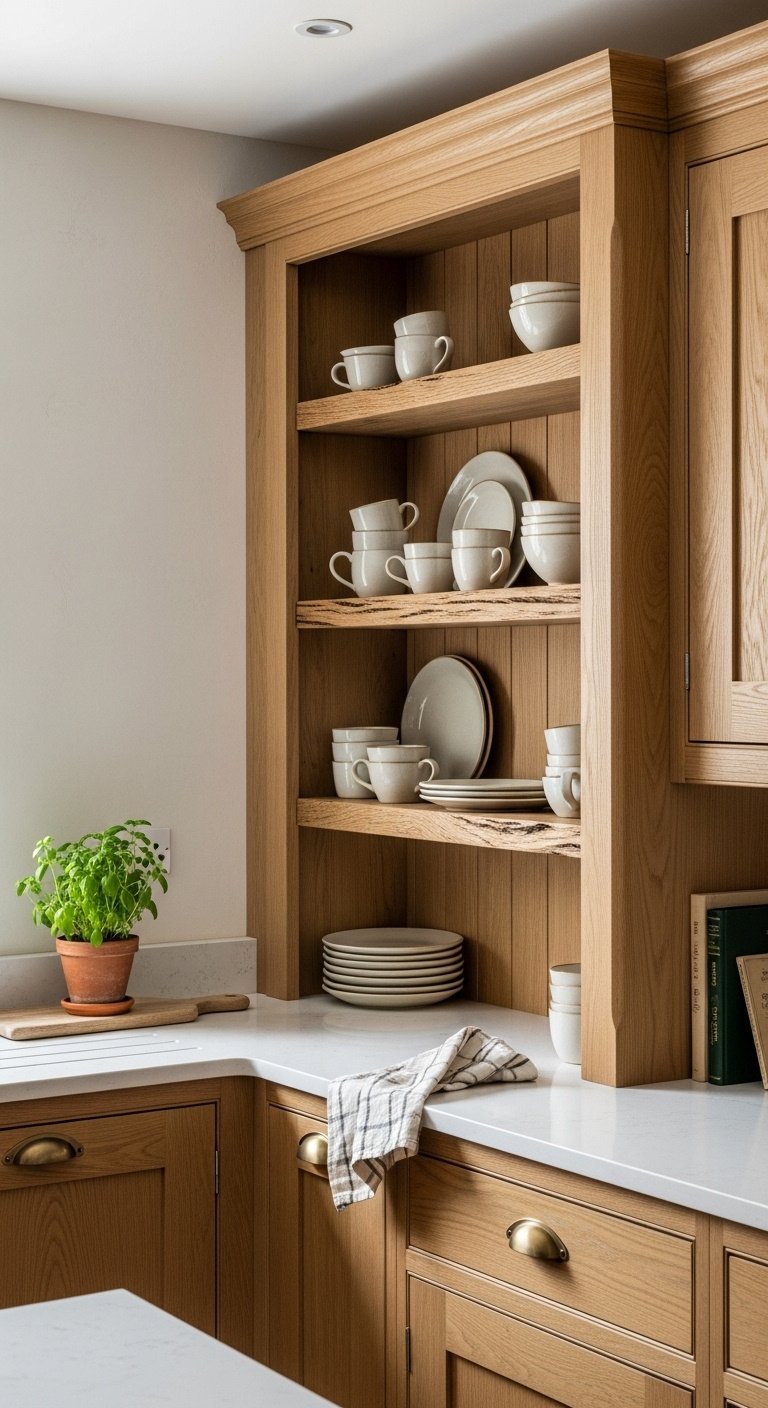
- Materials Needed: Natural wood cabinets (oak, walnut, or pine), or a high-quality wood veneer. Floating shelf brackets. Butcher block slab. Food-safe mineral oil.
- Step-by-Step Directions:
- Select Your Wood: Choose a wood species with a warm undertone and visible grain, like oak or walnut, for your cabinets. These woods are durable and bring immense character.
- Install Open Shelving: For a modern, airy feel, replace one or two upper cabinets with thick, rough-hewn wooden shelves. Use them to display earthy ceramics, glassware, and your favorite cookbooks.
- Add a Butcher Block: Consider a butcher block countertop for an island or a specific prep section. It’s a functional, warm surface that adds a touch of farmhouse charm.
- Finish Naturally: Treat wood surfaces with a clear matte sealant or food-safe oil. This protects the wood while allowing its natural beauty and texture to shine through, avoiding a glossy, artificial look.
Pro-Tip: “When selecting wood, look for pieces with interesting grain patterns or knots. From my experience, these ‘imperfections’ are what give an earthy kitchen its unique character and soul. They tell a story and keep the space from feeling mass-produced.”
Pin this warm wood kitchen inspiration for your dream remodel!
2. Introduce Calming Earthy Green Cabinetry
To infuse your kitchen with a deep sense of tranquility and a direct nod to nature, paint your cabinets in a calming earthy green shade like olive or sage. Green is the color of life and renewal, and bringing it into the kitchen creates a soothing atmosphere that feels both fresh and sophisticated. This approach works beautifully in modern earth tone kitchens and pairs exceptionally well with wood accents, brass hardware, and creamy neutral walls.
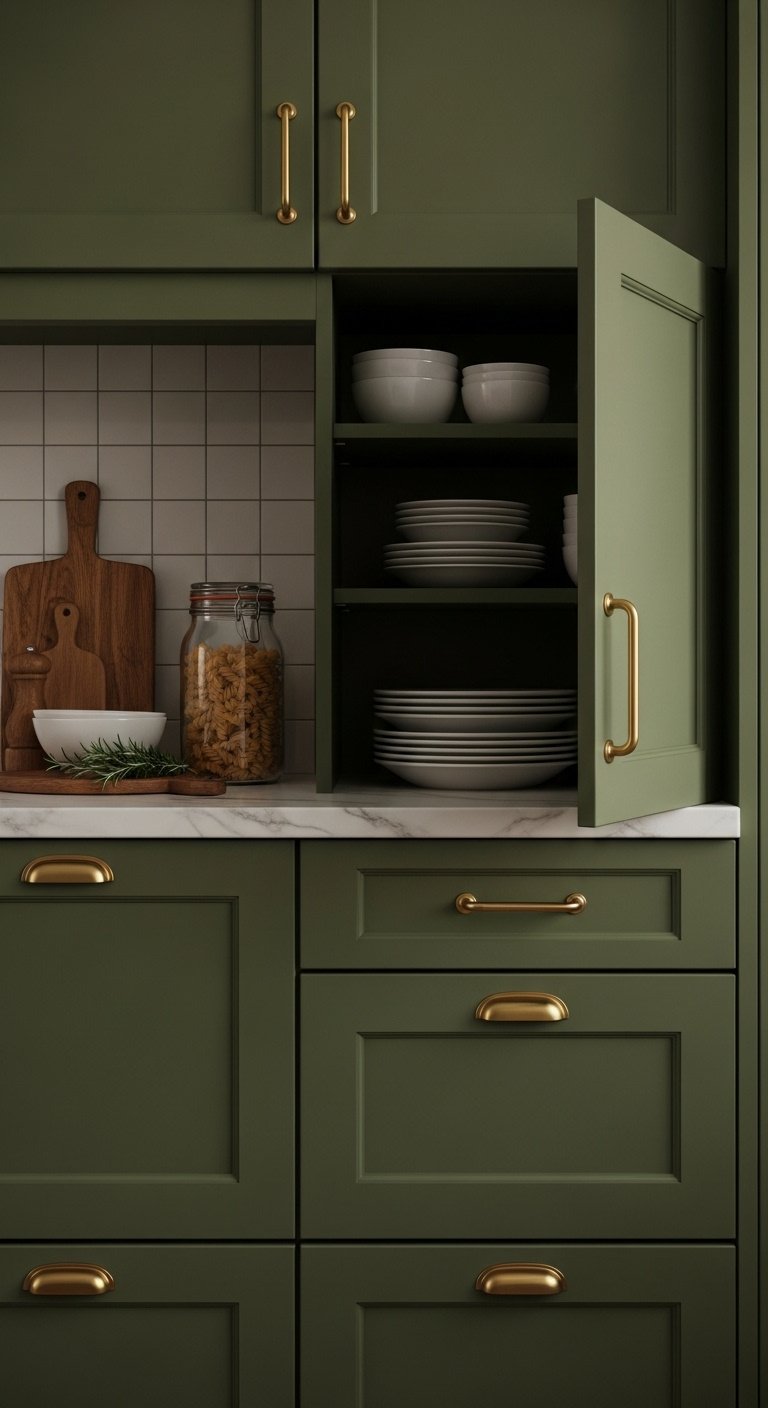
- Materials Needed: High-quality cabinet paint (e.g., in Olive Green or Muted Sage). Primer. Sandpaper (120-grit). Paint rollers and brushes. Degreaser. New cabinet hardware.
- Step-by-Step Directions:
- Prep Your Cabinets: This is the most crucial step. Remove cabinet doors and hardware. Thoroughly clean all surfaces with a degreaser to remove any grease or grime.
- Sand and Prime: Lightly sand the surfaces to create a texture for the primer to grip onto. Apply one even coat of a high-quality primer and let it dry completely.
- Apply Color: Once the primer is dry, apply two coats of your chosen earthy green paint, allowing for proper drying time between coats as recommended by the manufacturer. Opt for a matte or eggshell finish for a soft, modern, and non-reflective look.
- Update Hardware: Install new hardware to complete the transformation. Warm metals like brushed brass, antique gold, or even copper beautifully complement earthy green tones.
Pro-Tip: “From my own projects, I can’t stress this enough: test your green paint sample on a small, hidden part of a cabinet first. The color can look dramatically different depending on your kitchen’s natural and artificial lighting throughout the day. What looks like a soft sage in the store might appear minty under your kitchen’s LED lights.”
Love this color? Save it to your ‘Kitchen Color Palettes’ board!
3. Ground the Space with Natural Stone Surfaces
To achieve an authentic earthy aesthetic that feels permanent and luxurious, ground your kitchen design with natural stone surfaces for countertops, backsplashes, or a statement island. Materials like granite, marble, quartzite, limestone, and soapstone bring millions of years of natural history into your home. Their unique veining, organic patterns, and tactile textures are impossible to replicate, ensuring your kitchen is a one-of-a-kind space that mirrors the beauty of outdoor landscapes.
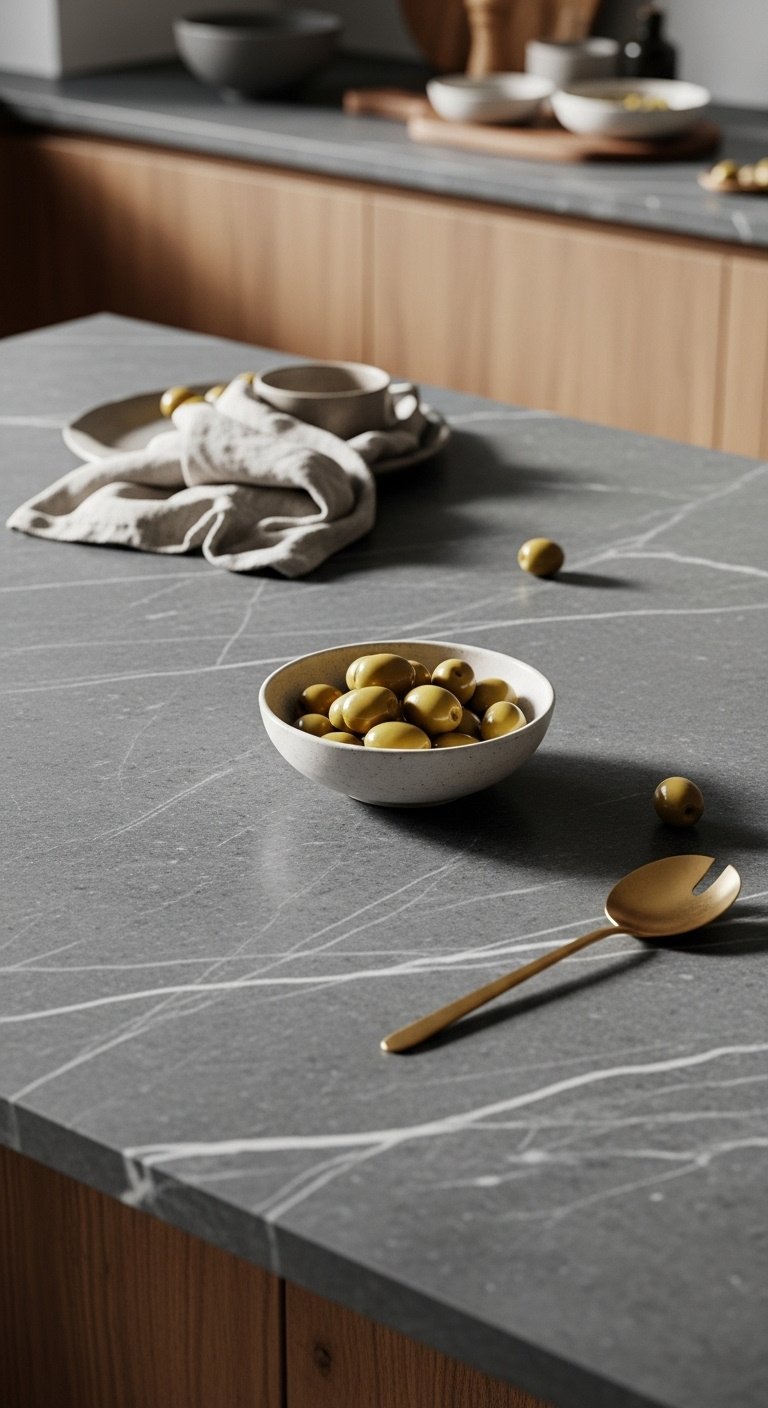
- Materials Needed: Chosen natural stone slab (e.g., granite, soapstone) or tiles (e.g., limestone). Professional measurement and installation services. Sealant appropriate for the stone type.
- Step-by-Step Directions:
- Research Stone Types: Explore the pros and cons of different stones. Granite is incredibly durable, soapstone offers a moody, rustic look that patinas beautifully, and honed marble provides a soft, classic elegance. Be sure to understand their maintenance needs.
- Visit a Stoneyard: This is a non-negotiable step. You must view full slabs in person to see the unique veining and color variations that photos simply can’t capture.
- Consider a Backsplash: For a high-impact update without replacing all countertops, create a stunning backsplash using textured stone tiles like slate, travertine, or limestone.
- Ensure Proper Sealing: Work with your installer to ensure the stone is properly sealed upon installation to protect against stains and etching. Learn the required maintenance schedule to keep it looking beautiful for decades.
Lesson Learned: “Many homeowners underestimate the importance of seeing a full stone slab. I’ve seen clients fall in love with a tiny sample, only to be surprised by a large, dramatic vein running through the slab they received. Always, always choose your exact slab at the supplier to ensure you love every inch of it.”
Add this stunning stone inspiration to your ‘Dream Kitchen’ board!
4. Layer In Organic Textiles and Woven Textures
An easy and affordable way to infuse an earthy kitchen with immediate warmth and softness is by layering in organic textiles and woven textures. These elements break up the hard surfaces of cabinetry and countertops, adding a crucial layer of comfort and tactile appeal. Materials like linen, jute, rattan, and raw cotton introduce a handmade, artisanal feel that makes a space feel lived-in, cozy, and thoughtfully designed.

- Materials Needed: Jute or sisal runner rug. Linen or raw cotton dish towels. Woven rattan or bamboo pendant light shade. Woven baskets for storage.
- Step-by-Step Directions:
- Soften the Floor: Place a durable jute or sisal runner in front of the sink area. Its natural, coarse texture is comfortable underfoot, defines the workspace, and adds immense warmth.
- Swap Your Linens: Replace standard polyester dish towels with high-quality linen or waffle-knit cotton towels. Drape them over your oven handle or sink in earthy tones like beige, rust, or moss green.
- Add a Statement Light: Hang one or more woven pendant lights over your kitchen island or dining nook. The natural material creates a soft, diffused glow and serves as a beautiful, organic focal point.
- Corral Clutter: Use woven baskets on countertops or open shelves to stylishly store fruits, vegetables, or even cooking utensils. This keeps things tidy while adding another layer of natural texture.
Pro-Tip: “Don’t be afraid to mix different woven textures. From my experience in styling spaces, combining a smooth linen, a chunky jute, and a fine rattan creates a rich, layered look that feels professionally designed and thoughtfully curated.”
Save these cozy texture ideas to your ‘Home Decor’ board!
5. Create a Warm Focal Point with Terracotta
For a powerful dose of Mediterranean warmth and rustic charm, create a focal point in your kitchen using terracotta. This ancient, earthy material—literally “baked earth”—glows with a warm, reddish-brown hue that is instantly inviting. Whether used extensively on the floor, as a characterful backsplash, or in small decorative doses, terracotta brings a sense of history and handcrafted beauty to the heart of your home.
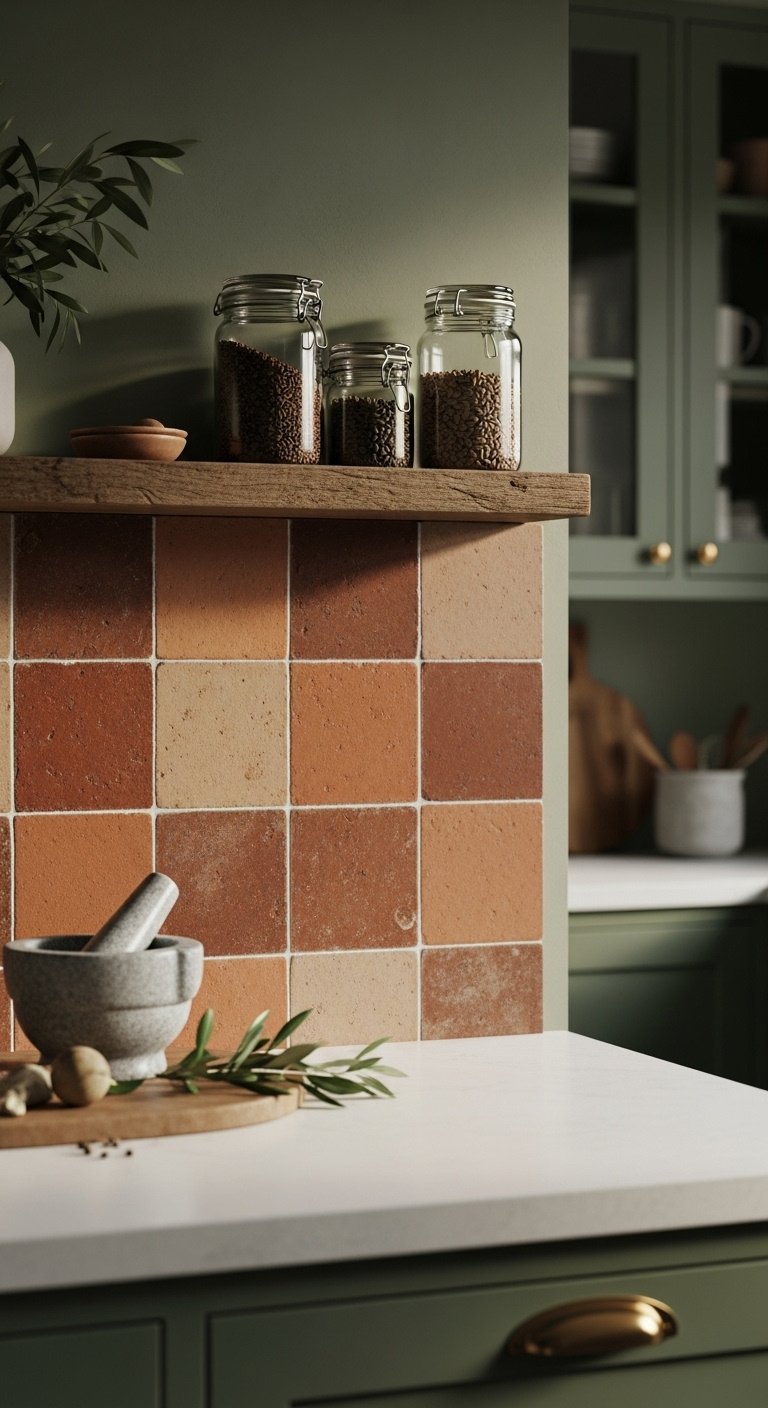
- Materials Needed: Terracotta tiles (e.g., zellige or Saltillo). Tile adhesive and grout. Tile cutter and trowel. Terracotta herb pots.
- Step-by-Step Directions:
- Design a Backsplash: Install terracotta tiles behind your stove or sink. Handmade zellige or Saltillo tiles, with their natural imperfections and color variations, create a stunning, textured backsplash.
- Consider Flooring: For a truly immersive, warm, and durable foundation, use larger terracotta tiles for the kitchen floor. They are excellent for high-traffic areas and develop a beautiful patina over time.
- Add Small Accents: If a renovation isn’t in the cards, an easy way to get the look is to group small terracotta pots on a windowsill. Plant them with kitchen herbs like basil, rosemary, and thyme for a touch of functional greenery.
- Display Clay Cookware: Showcase beautiful clay or earthenware cooking vessels, like a tagine or bean pot, on open shelves. They serve as both functional tools and rustic decor.
Lesson Learned: “A common mistake I’ve seen is forgetting that natural terracotta is porous. It needs to be sealed properly, especially when used for flooring or a backsplash, to prevent staining from water and oils. Don’t skip this crucial step, or you’ll be dealing with spots forever!”
Pin this warm terracotta idea for a splash of color!
6. Maximize Natural Light & Bring Greenery Indoors
The most vital elements for an earthy kitchen are also the most alive: maximize natural light and bring abundant greenery indoors. Light is the lifeblood of any space, making colors appear truer and textures more pronounced. Paired with living plants, it creates a vibrant, healthy environment that truly blurs the line between inside and out. This biophilic approach is essential for enhancing the earthy essence, improving air quality, and creating a welcoming vibe.
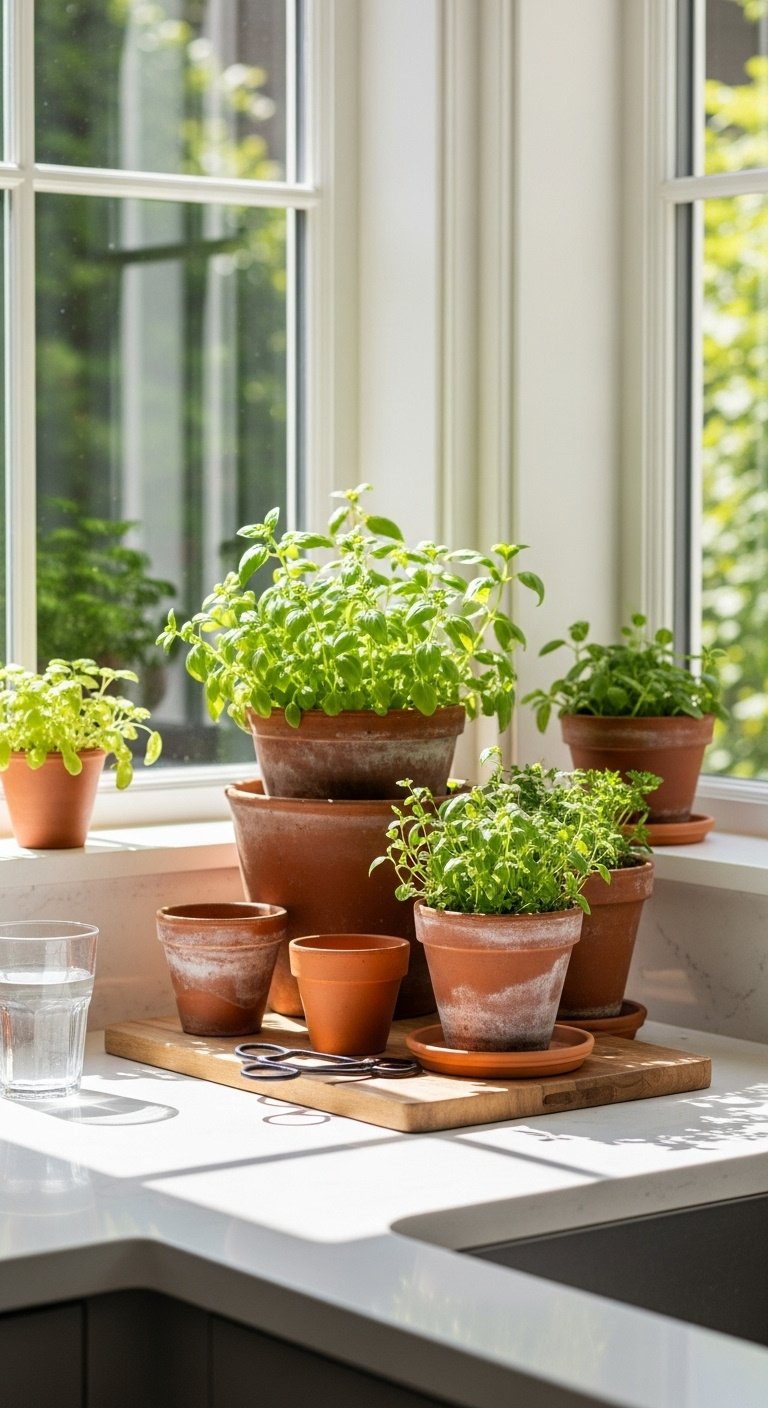
- Materials Needed: Various indoor plants (herbs, pothos, snake plants). Well-draining potting mix. Ceramic or terracotta pots. Sheer linen curtains (optional).
- Step-by-Step Directions:
- Keep Windows Clear: If privacy allows, remove heavy curtains or blinds to let in the maximum amount of natural light. If you need some covering, opt for light and airy sheer linen cafe curtains that cover only the bottom half of the window.
- Create a Windowsill Herb Garden: This is a classic for a reason. Plant pots of basil, mint, parsley, and rosemary and place them on your sunniest windowsill. They provide fresh flavors, wonderful scents, and a touch of green.
- Hang a Trailing Plant: Place a low-maintenance trailing plant like a pothos or philodendron on top of your cabinets or on a high shelf. Its cascading vines create a beautiful, organic effect and draw the eye upward.
- Use a Statement Plant: If you have a free corner, add a larger floor plant like a Fiddle Leaf Fig or a Snake Plant. It makes a significant impact and acts as living art.
Pro-Tip: “My best advice from years of incorporating plants into design is to choose your kitchen plants based on the amount of natural light the spot actually receives. Herbs need lots of direct sun to thrive, while snake plants and ZZ plants are champions of lower light conditions. Matching the plant to the place is the secret to success.”
Ready to grow? Save this kitchen garden idea now!
7. Add History with Rustic & Copper Accents
To give your earthy kitchen a final layer of soul and prevent it from feeling too new, add character and history with rustic and copper accents. These are the finishing touches that tell a story. Vintage finds, repurposed items, and metals that develop a patina over time—like copper—add a sense of age and charm. Wrought iron, antique wood, and handmade ceramics bring a sense of authenticity that can’t be bought in a big-box store.
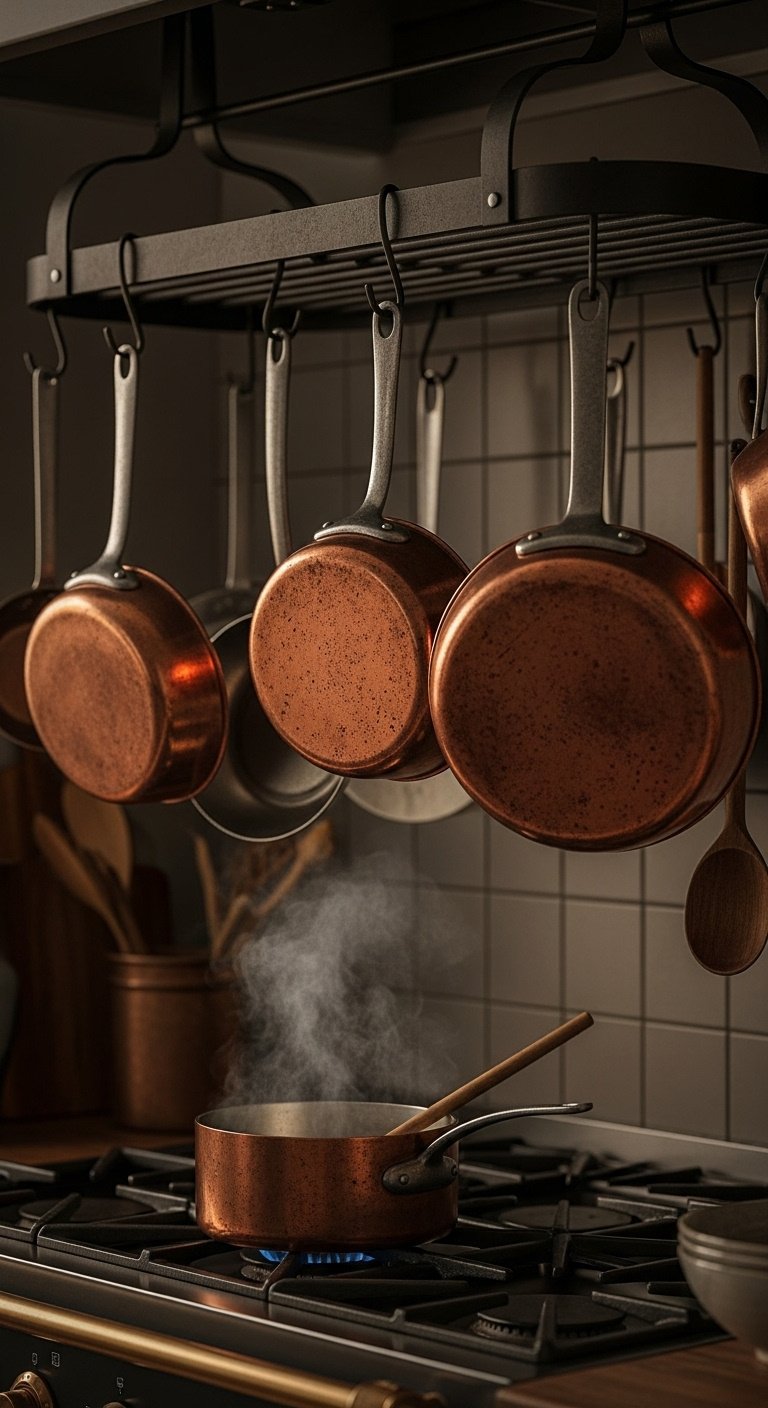
- Materials Needed: Copper hardware or sink. Wrought iron pot rack. Vintage copper pots (for display). Driftwood or nature-inspired art.
- Step-by-Step Directions:
- Upgrade Your Sink: For a major statement piece, consider a copper farmhouse sink. It becomes the undeniable star of the kitchen and develops a beautiful, unique patina over time.
- Hang a Pot Rack: Install a wrought iron pot rack above an island or stove. Use it to hang copper or cast-iron cookware, blending practical storage with beautiful, rustic decor.
- Incorporate Vintage Finds: Scour flea markets, antique shops, and even your own attic for antique copper pots, vintage wooden crates, old cutting boards, or stoneware jugs to use as decorative accents.
- Choose Nature-Inspired Art: Don’t forget the walls. Hang art featuring landscapes, botanicals, or simply display a beautiful piece of sculptural driftwood on an open shelf.
Lesson Learned: “Real copper will naturally tarnish and change color—this is part of its charm and what gives it that living finish. If you prefer a constant, new-penny shine, be prepared for a routine of regular polishing. From my experience, embracing the patina is much easier and aligns better with the rustic, earthy aesthetic.”
Add a touch of history! Pin these rustic accent ideas.
Key Takeaways: Your Quick Guide to a Natural Earthy Kitchen
Creating a natural earthy kitchen is about making thoughtful choices that prioritize warmth, texture, and a connection to the outdoors. Here are the most important points to remember as you begin your design journey:
- Focus on Natural Materials: Wood, stone, clay, and organic fibers are the non-negotiable foundation of the look. They bring authentic texture and soul to the space.
- Embrace a Warm Palette: Draw your colors from a forest floor or a desert landscape. Think muted greens, warm beiges, rich terracotta, and soft browns.
- Texture is Key: A truly successful earthy kitchen engages more than just the eyes. Layer different textures—from rough-hewn wood to smooth stone and woven textiles—to add depth and sensory richness.
- Maximize Natural Light: Keep windows unobstructed to let the sunshine in. Supplement this by adding plenty of indoor plants to literally bring the outdoors in.
- Add Personal, Rustic Touches: The final layer is character. Incorporate vintage items, handmade pottery, and warm metal accents like copper or brass to make the kitchen uniquely yours.
People Also Ask About Natural Earthy Kitchens
What are the colors for an earthy kitchen?
The best colors for an earthy kitchen are drawn directly from nature. Start with a base of warm neutrals like beige, sand, and warm whites to keep the space feeling bright. Layer in deeper hues inspired by the landscape, such as olive green, sage green, and muted blues. For warm and inviting accent colors, consider terracotta, burnt sienna, rust, and mustard yellow to add depth and personality.
What is the 2025 kitchen color?
In 2025, the biggest kitchen color trend is the definitive shift towards warm neutrals and rich, earthy tones. Expect to see calming beige, sand, and taupe hues being used as sophisticated base colors. Terracotta and clay are making a huge comeback, adding a touch of rustic warmth. To complete the look, subtle olive greens and soft, earthy browns are incredibly popular for bringing a biophilic, nature-inspired connection into the kitchen.
What is the kitchen triangle rule?
The kitchen triangle rule is a classic design guideline for creating an efficient and ergonomic kitchen layout. It suggests that the three main work areas—the refrigerator (food storage), the sink (cleaning), and the stove (cooking)—should form a natural triangle. The idea is to minimize the steps a cook has to take between these key zones, creating a smooth, unobstructed workflow that makes kitchen tasks easier.
Final Thoughts
Creating a natural earthy kitchen is about more than just following a design trend; it’s about fundamentally changing how your space feels. It’s a conscious choice to craft a sanctuary that nurtures and grounds you every single day. By thoughtfully weaving together natural materials, warm colors, and personal touches, you can design a kitchen that is not only beautiful and functional but also a true reflection of a calm, connected, and soulful way of living.
What natural element are you most excited to bring into your kitchen? Let us know in the comments below
